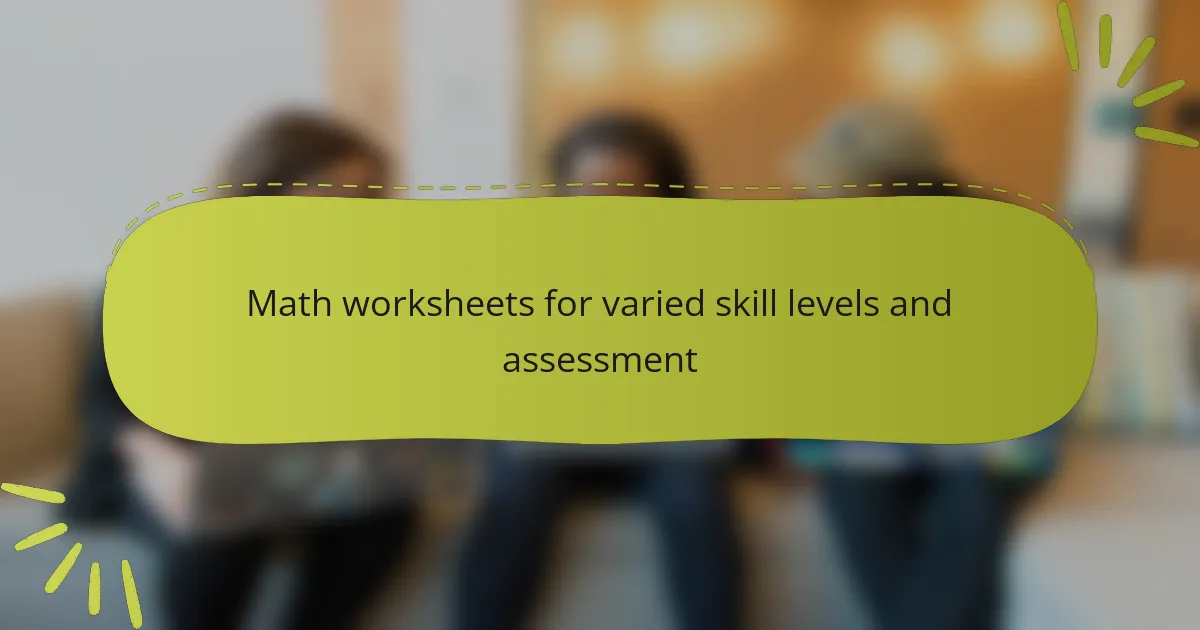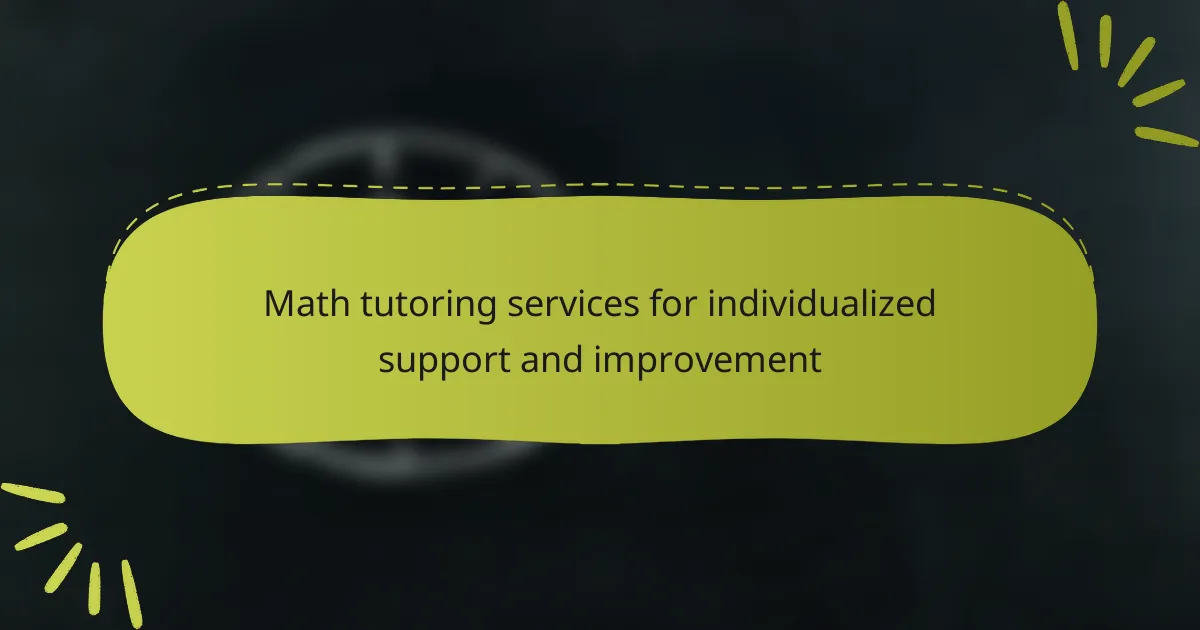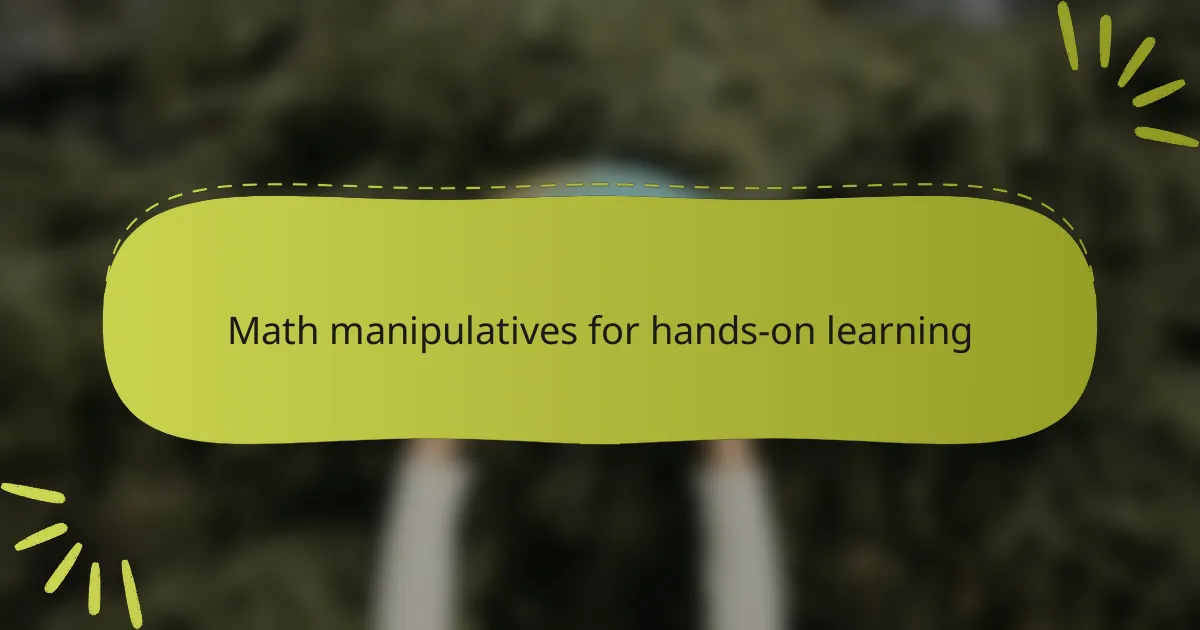Math textbooks for comprehensive understanding and curriculum alignment are essential educational resources that support effective learning in mathematics across various educational levels. These textbooks are aligned with educational standards and provide structured content that encompasses key mathematical concepts and skills, including clear explanations, examples, and practice problems. They also incorporate assessments to measure student comprehension and may feature real-world applications to enhance relevance. Different types of math textbooks cater to specific educational stages, from elementary arithmetic to advanced college subjects, while best practices for selection emphasize alignment with curriculum standards, clarity, and the inclusion of supplemental resources.
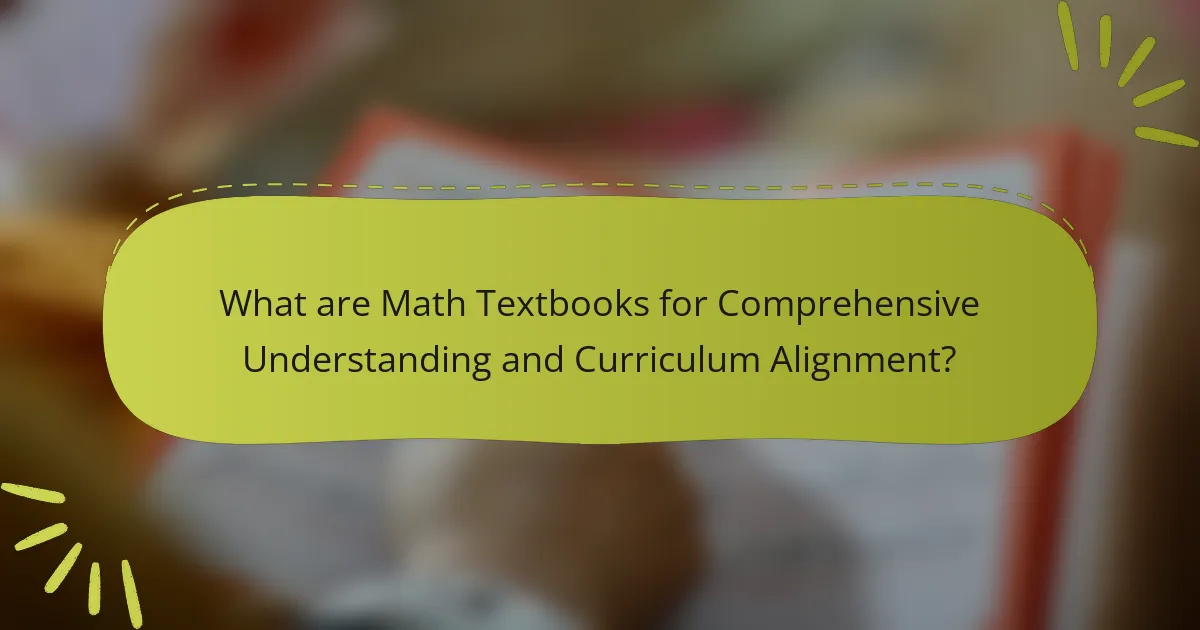
What are Math Textbooks for Comprehensive Understanding and Curriculum Alignment?
Math textbooks for comprehensive understanding and curriculum alignment are educational resources designed to facilitate effective learning in mathematics. These textbooks align with educational standards and curriculum frameworks. They provide structured content that covers essential mathematical concepts and skills. Comprehensive understanding is achieved through clear explanations, examples, and practice problems. The textbooks often include assessments to gauge student comprehension. They may also incorporate real-world applications to enhance learning relevance. Research shows that aligned textbooks improve student performance and engagement. Studies indicate that effective alignment with standards leads to better educational outcomes.
How do Math Textbooks support comprehensive understanding?
Math textbooks support comprehensive understanding by providing structured content, clear explanations, and varied practice problems. They break down complex concepts into manageable sections. This allows students to build knowledge progressively. Textbooks often include visual aids, such as graphs and diagrams, to enhance comprehension. Additionally, they offer real-world applications to demonstrate relevance. Many textbooks align with educational standards, ensuring that essential topics are covered. Research shows that structured materials improve retention and understanding (National Mathematics Advisory Panel, 2008). This alignment helps educators assess student progress effectively. Overall, math textbooks are vital tools for fostering a deep understanding of mathematical principles.
What key concepts do Math Textbooks cover for effective learning?
Math textbooks cover essential concepts such as number theory, algebra, geometry, and statistics for effective learning. These concepts build foundational skills necessary for advanced mathematical understanding. Number theory introduces the properties of numbers and operations. Algebra focuses on variables, equations, and functions. Geometry explores shapes, sizes, and spatial relationships. Statistics teaches data analysis and interpretation. Each concept is systematically presented to align with educational standards. This structured approach enhances comprehension and retention. Research shows that textbooks incorporating these key concepts improve student performance in mathematics.
How do different learning styles influence the design of Math Textbooks?
Different learning styles significantly influence the design of math textbooks. Textbooks are tailored to accommodate visual, auditory, and kinesthetic learners. Visual learners benefit from diagrams, charts, and illustrations. Auditory learners appreciate explanations and discussions presented in text. Kinesthetic learners require hands-on activities and real-world applications. Research shows that textbooks incorporating diverse styles enhance student engagement and comprehension. For example, a study by Pashler et al. (2008) indicates that varied instructional methods improve learning outcomes. Thus, effective math textbooks integrate multiple learning styles to support diverse student needs.
Why is curriculum alignment important in Math Textbooks?
Curriculum alignment is important in math textbooks because it ensures that content meets educational standards. Aligned textbooks support cohesive learning experiences for students. They provide a structured approach to teaching mathematical concepts. This alignment helps educators identify key learning objectives. Research shows that aligned materials improve student performance. A study by the National Mathematics Advisory Panel found that curriculum coherence is linked to higher student achievement. Consequently, curriculum alignment in math textbooks is essential for effective teaching and learning.
What are the standards for curriculum alignment in mathematics education?
Standards for curriculum alignment in mathematics education include coherence, focus, and rigor. Coherence ensures that content is logically structured and connected across grade levels. Focus emphasizes the importance of prioritizing key concepts and skills. Rigor involves a balance of conceptual understanding, procedural skills, and application. These standards guide educators in developing curricula that meet educational goals. The National Council of Teachers of Mathematics (NCTM) provides frameworks that support these standards. Their guidelines promote effective teaching practices and student engagement in mathematics.
How do Math Textbooks ensure they meet curriculum standards?
Math textbooks ensure they meet curriculum standards by aligning content with educational frameworks. They incorporate state and national standards in their development process. This alignment involves careful mapping of topics and skills required by the curriculum. Publishers often consult educators and curriculum experts during the creation of textbooks. They also conduct reviews to ensure accuracy and relevance. Many textbooks include assessments that reflect curriculum expectations. Additionally, revisions are made based on feedback from teachers and educational institutions. This systematic approach helps maintain compliance with established educational standards.
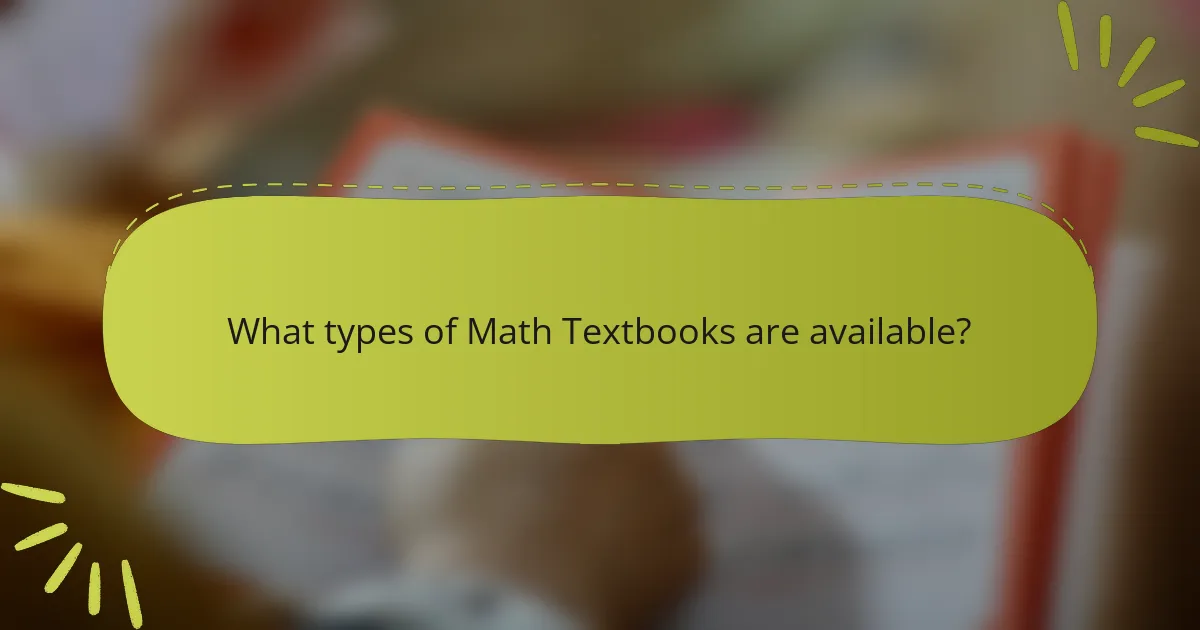
What types of Math Textbooks are available?
There are several types of math textbooks available. These include textbooks for elementary mathematics, which cover basic arithmetic and foundational concepts. Middle school math textbooks typically introduce algebra and geometry topics. High school math textbooks often focus on advanced subjects like calculus, statistics, and trigonometry. College-level math textbooks cater to specialized areas such as linear algebra, abstract algebra, and differential equations. Additionally, there are supplemental textbooks that provide practice problems and solutions. Textbooks may also vary by teaching approach, including traditional, inquiry-based, or integrated methods. Each type serves specific educational levels and curriculum standards.
How do traditional Math Textbooks differ from digital formats?
Traditional math textbooks are physical books, while digital formats are electronic resources. Traditional textbooks require physical storage and can be cumbersome to carry. Digital formats are easily accessible on multiple devices, allowing for portability. Traditional textbooks often have fixed content, while digital formats can be updated regularly. Interactive features like videos and quizzes are common in digital formats, enhancing engagement. Traditional textbooks provide a linear reading experience, whereas digital formats allow for non-linear navigation. Research indicates that students using digital formats often show improved engagement and retention compared to those using traditional textbooks.
What are the advantages of using digital Math Textbooks?
Digital math textbooks offer several advantages. They provide interactive features that enhance student engagement. These textbooks often include multimedia resources such as videos and animations. This can help clarify complex mathematical concepts. Additionally, digital formats allow for easy updates and access to the latest information. Students can access their textbooks from multiple devices, promoting flexibility in learning. Many digital math textbooks also offer built-in assessment tools. These tools can track student progress in real-time. Research indicates that digital textbooks can improve learning outcomes by catering to diverse learning styles.
How do print Math Textbooks facilitate learning in different environments?
Print math textbooks facilitate learning in different environments by providing structured content and visual aids. They offer clear explanations of mathematical concepts, which help learners grasp complex topics. The physical format allows for easy annotation and note-taking, enhancing retention. Additionally, print textbooks are accessible without the need for technology, making them suitable for various settings. Studies show that students often perform better with print materials compared to digital formats, especially in comprehension tasks. This is supported by research from the University of California, which indicates that print aids in deeper cognitive processing. Overall, print math textbooks create a conducive learning atmosphere across diverse educational contexts.
What specialized Math Textbooks exist for various educational levels?
Specialized math textbooks exist for various educational levels, including elementary, middle school, high school, and college. For elementary education, textbooks like “Math in Focus” and “Everyday Mathematics” are commonly used. Middle school students often use “Pre-Algebra” by McDougal Littell or “Mathematics: A Common Core Approach.” High school curricula include “Algebra and Trigonometry” by Robert F. Blitzer and “Calculus” by James Stewart. For college-level courses, textbooks such as “Linear Algebra and Its Applications” by David C. Lay and “Introduction to the Theory of Computation” by Michael Sipser are prevalent. These textbooks are aligned with educational standards and provide comprehensive understanding of mathematical concepts.
Which Math Textbooks are best suited for elementary education?
The best math textbooks for elementary education include “Math Expressions,” “Everyday Mathematics,” and “Go Math!” These textbooks align well with curriculum standards. “Math Expressions” emphasizes conceptual understanding and problem-solving. “Everyday Mathematics” uses real-world applications to engage students. “Go Math!” provides a structured approach with interactive learning. Each textbook is widely adopted across various school districts. They are designed to meet the needs of diverse learners. Research indicates these textbooks improve student performance in math.
What resources are available for high school mathematics curricula?
High school mathematics curricula have various resources available. These include textbooks, online platforms, and supplementary materials. Textbooks like “Algebra and Trigonometry” by Michael Sullivan and “Calculus” by James Stewart are widely used. Online platforms such as Khan Academy and IXL offer interactive lessons and practice exercises. Additionally, resources like Mathletics and ALEKS provide personalized learning experiences. Teacher guides and lesson plans are also available to support curriculum alignment. These resources collectively enhance student understanding and engagement in mathematics.
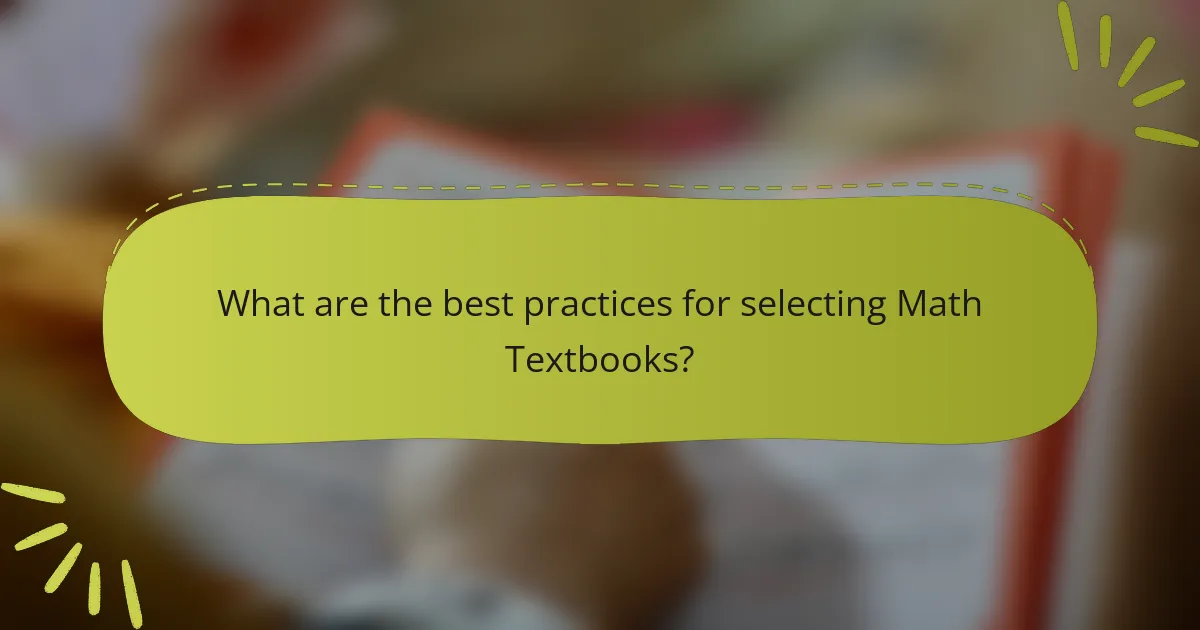
What are the best practices for selecting Math Textbooks?
Best practices for selecting math textbooks include evaluating alignment with curriculum standards. Textbooks should meet state or national educational guidelines. Consider the book’s clarity and organization. Clear explanations and logical progression are essential for student understanding. Review the types of exercises provided. A good textbook offers varied problem types to reinforce concepts. Check for supplemental resources such as online materials or teacher guides. These resources can enhance the learning experience. Assess the textbook’s relevance to students’ needs. Textbooks should engage students and relate to real-world applications. Finally, gather feedback from educators who have used the textbook. Their insights can provide valuable information on effectiveness and usability.
How can educators evaluate the effectiveness of Math Textbooks?
Educators can evaluate the effectiveness of Math textbooks by analyzing their alignment with curriculum standards. They should review the content for clarity, relevance, and engagement. Educators can also assess the variety of exercises and their alignment with learning objectives. Additionally, they can gather feedback from students regarding their comprehension and interest. Comparing student performance data before and after using the textbooks can provide insights into their effectiveness. Research indicates that textbooks aligned with educational standards improve student outcomes. A study by the Institute for Education Sciences found that well-structured materials enhance learning results.
What criteria should be considered when choosing Math Textbooks?
When choosing math textbooks, consider alignment with curriculum standards. Textbooks should meet national or state educational guidelines. Evaluate the clarity and accuracy of explanations. Clear concepts enhance student understanding. Assess the variety of practice problems provided. A range of problems reinforces learning. Look for supplemental resources included. Resources like online materials can aid instruction. Review the textbook’s organization and structure. A logical flow aids comprehension. Consider the level of engagement and interactivity. Engaging content can motivate students to learn. Lastly, check for reviews and recommendations. Feedback from educators can guide your choice.
How do reviews and recommendations influence textbook selection?
Reviews and recommendations significantly influence textbook selection by guiding educators toward quality resources. Educators often rely on peer reviews to assess the effectiveness of textbooks. Positive reviews can enhance a textbook’s credibility and appeal. Conversely, negative feedback may deter selection. Recommendations from trusted sources, such as colleagues or educational institutions, further shape choices. Studies indicate that 70% of educators consult reviews before making decisions. This reliance on collective insights ensures that selected textbooks align with curriculum standards and student needs.
What tips can help maximize the use of Math Textbooks in the classroom?
Utilizing math textbooks effectively in the classroom involves several strategies. First, align textbook content with curriculum standards. This ensures that all necessary topics are covered. Second, incorporate diverse teaching methods. Use visual aids, group activities, and discussions to enhance understanding. Third, encourage student interaction with the text. Ask students to annotate, highlight, and summarize key concepts. Fourth, integrate real-world applications. This helps students see the relevance of math in everyday life. Lastly, regularly assess comprehension. Use quizzes and discussions to gauge understanding and adjust teaching methods accordingly. These strategies have been shown to improve student engagement and learning outcomes in mathematics education.
How can teachers integrate Math Textbooks with technology for enhanced learning?
Teachers can integrate math textbooks with technology by utilizing digital platforms and interactive tools. These tools can enhance engagement and understanding of mathematical concepts. For example, online resources can provide interactive exercises that align with textbook content. Teachers can also use educational software that complements textbook lessons with visual aids. Incorporating video tutorials can clarify complex topics presented in textbooks. Additionally, using learning management systems allows for easy access to supplemental materials. Research indicates that technology integration can improve student performance in mathematics. A study by the National Education Association found that students who engage with technology-enhanced learning show higher retention rates.
What strategies can be employed to engage students with Math Textbooks?
Employing interactive elements in math textbooks can significantly engage students. Incorporating visual aids, such as graphs and diagrams, helps clarify complex concepts. Including real-world applications of math fosters relevance and interest. Providing practice problems with varying difficulty levels encourages mastery. Integrating technology, like QR codes linking to online resources, enhances learning. Using collaborative activities in textbooks promotes peer engagement. Offering reflective questions encourages critical thinking. These strategies align with educational research showing that active learning improves student outcomes.
Math textbooks for comprehensive understanding and curriculum alignment are essential educational resources that facilitate effective learning in mathematics by adhering to educational standards and frameworks. These textbooks provide structured content, covering key mathematical concepts such as number theory, algebra, geometry, and statistics, while accommodating various learning styles through diverse instructional methods. The article explores how these textbooks support comprehension, the significance of curriculum alignment, and best practices for selecting and utilizing them in classrooms, highlighting their impact on student engagement and performance. Additionally, it discusses the advantages of both traditional and digital formats, as well as specialized resources available for different educational levels.
